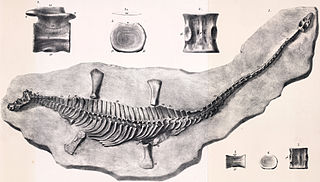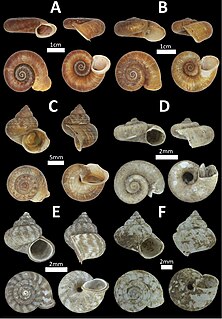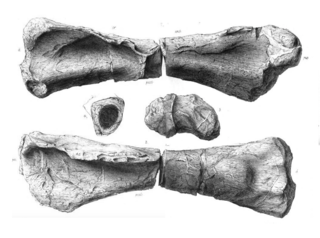
Helix is a genus of large, air-breathing land snails native to Europe and the Mediterranean region. They are the type genus of the family Helicidae, and are among the first animal genera described by Carl Linnaeus. Members of the genus first appeared during the Oligocene. Like most land snails, Helix species are hermaphroditic, and like other helicids, a courting pair will impale each other with hormone-rich love darts prior to exchanging sperm. Well-known species include Helix pomatia and Helix lucorum. Cornu aspersum – another well-known helicid – was originally described as a member of Helix, but the prevailing classification places it as the sole member of the sister genus Cornu.

Magnosaurus was a genus of theropod dinosaur from the Middle Jurassic of England. It is based on fragmentary remains and has often been confused with or included in Megalosaurus.

Szechuanosaurus is an extinct genus of carnivorous theropod dinosaur from the Late Jurassic. Fossils referred to the genus have been found in China, Asia in the Oxfordian-?Tithonian. Its type species is largely based on several undiagnostic teeth from the Shangshaximiao Formation and it is possibly also known from the Kuangyuan Series and the Kalaza Formation, both also located in China.

Pelochelys is a genus of very large softshell turtles in the family Trionychidae. They are found from peninsular India northeast to southern China, and south to Southeast Asia and New Guinea.

Rhomaleosaurus is an extinct genus of Early Jurassic rhomaleosaurid pliosauroid known from Northamptonshire and from Yorkshire of the United Kingdom. It was first named by Harry Seeley in 1874 and the type species is Rhomaleosaurus cramptoni. It was one of the earliest large marine reptile predators which hunted in the seas of Mesozoic era. Its length was about 7 m (23 ft) long. Like other pliosaurs, Rhomaleosaurus fed on ichthyosaurs, ammonites and other plesiosaurs.

Microcleidus is an extinct genus of sauropterygian reptile belonging to the Plesiosauroidea. It was about the size of a medium-sized dolphin, reaching a length of 3 metres (9.8 ft). The species has 40 neck vertebrae and a short tail of 28 vertebrae. Fossils of the genus have been found in France, the Posidonia Shale in Germany and Luxembourg, and the Alum Shale Formation of England.

Lamiinae, commonly called flat-faced longhorns, are a subfamily of the longhorn beetle family (Cerambycidae). The subfamily includes over 750 genera, rivaled in diversity within the family only by the subfamily Cerambycinae.

Diplommatinidae is a family of small land snails, also known as staircase snails, with an operculum, terrestrial gastropod mollusks in the superfamily Cyclophoroidea. The Cochlostomatinae Kobelt, 1902, were previously considered a subfamily of the Diplommatinidae, but are now known to be a separate family.

Cyclophoridae is a taxonomic family of small to large tropical land snails with an operculum, terrestrial gastropod mollusks in the order Architaenioglossa belonging to the subclass Caenogastropoda.

Duriavenator is a genus of theropod dinosaur described in 2008 by Roger Benson; its finds were excavated in England. The only named species in the genus is Duriavenator hesperis, formerly known as Megalosaurus hesperis. Duriavenator lived during the Bajocian stage, between 169.1 and 168.7 million years ago, making it one of the oldest-known Tetanurae. The genus name combines the Latin name of Dorset, Duria, with Latin for "hunter", venator. This genus has also gone under the unofficial name "Walkersaurus", which is a nomen nudum. It has been estimated to be 7 meters in length.

Hauffiosaurus is an extinct genus of Early Jurassic pliosaurid plesiosaur known from Holzmaden of Germany and from Yorkshire of the United Kingdom. It was first named by Frank Robin O’Keefe in 2001 and the type species is Hauffiosaurus zanoni. In 2011, two additional species were assigned to this genus: H. longirostris and H. tomistomimus.

Eurycleidus is an extinct genus of large-bodied rhomaleosaurid known from the Early Jurassic period of the United Kingdom. It contains a single species, E. arcuatus. Like other plesiosaurs, Eurycleidus probably lived on a diet of fish, using its sharp needle-like teeth to catch prey. Its shoulder bones were fairly large, indicating a powerful forward stroke for fast swimming.

Seeleyosaurus is an extinct genus of plesiosaur that was initially placed within the genus Plesiosaurus in 1895 and was given its own genus in 1940. Two species were known: the type, S. guilelmiimperatoris, and the now obsolete species S. holzmadensis, which has since been absorbed into S. guilelmiimperatoris. The holotype was MB.R.1992, a large almost complete skeleton from the Upper Lias (Toarcian) Lias Group Formations of Württemberg, Germany. There seems to be the impression of a rhomboidal flap of skin in a vertical plane; if so, many plesiosaurs may have been equipped in this way. The holotype was destroyed in 1945 (WWII) and only a cast exists today. A second specimen, preserved in 3D, has survived until today. It was once the holotype of the now obsolete species S. holzmadensis.
William Henry Benson was a civil servant in British India and an amateur malacologist. He made large collections of molluscs and described numerous species from the U.K., India and South Africa.

Corilla is a genus of air-breathing land snails, terrestrial pulmonate gastropod mollusks in the family Corillidae. This family has no subfamilies. It has been synonymised with Atopa Albers, 1850 and Helix (Corilla) Adams & Adams, 1855.

Alycaeidae is a taxonomic family of small to large tropical land snails with an operculum, terrestrial gastropod mollusks in the superfamily Cyclophoroidea.

Duriatitan is a genus of titanosauriform sauropod dinosaur that lived in the Late Jurassic in what is now England. The holotype specimen of Duriatitan, BMNH 44635, is a partial left upper arm bone which was found by R.I. Smith near Sandsfoot in the lower Kimmeridge Clay from Dorset. The type species, D. humerocristatus, was described in 1874 by John Hulke as a species of Cetiosaurus. The specific name refers to the deltopectoral crest, crista, on the upper arm bone, humerus. The specimen was assigned to its own genus by Paul M. Barrett, Roger B.J. Benson and Paul Upchurch in 2010. The generic name is derived from the Latin name for Dorset, Duria, and Greek Titan. Thomas Hotlz estimated its length at 25 meters.

Juratyrant is a tyrannosauroid dinosaur genus from the late Jurassic period of England. The genus contains a single species, Juratyrant langhami, which was once classed as a species of Stokesosaurus.
Angulyagra is a genus of gastropods belonging to the family Viviparidae.
















